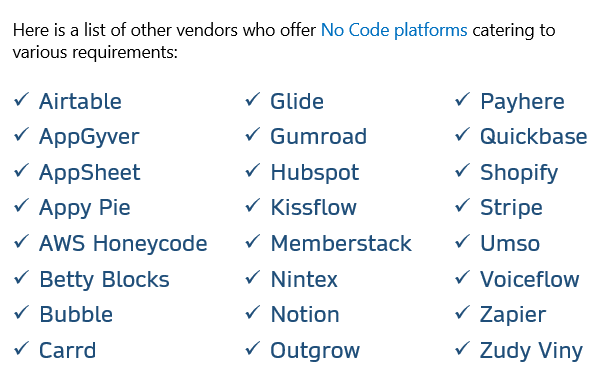
Low-code/no-code development platforms are typically visual software development platforms that allow developers and citizen developers to drag and drop application components, connect them together and create mobile or web apps.
Usually, these platforms offer a modular approach that let developers quickly build apps without writing code or sometimes with minimal code. In either case, they get a user-friendly graphical user interface (GUI), through which they can marry components and third-party application program interfaces (APIs).
Here below are the few areas, I feel where low-code no-code tools adaption would dominate / continue to grow in 2022.
1. Web Apps creation
With the help of sophisticated No Code App Builders, building applications has become easier than ever before. Web apps and Mobile apps building is now just a drag-n-drop configuration job with these no code platforms. These no code app builders also come with a variety of out-of-the-box integration tools and plugins that would enable you to extend your web app functionality in many ways, thus making your life easier. Some of the popular platforms include, Typedream, Bubble.io, Quickbase, Softr and many more.
2. Task Automation
No code platforms have increasingly become dominant in workflow automation. They help enhance business processes and provide other capabilities to contribute to your operations and help you grow. But this is not something new and we know BPM tools where available for long time in the industry. However, the recent technological advancements along with RPA and Intelligent Automation tools, the adaption rate of such tools has skyrocketed. The market is very competitive though with many options. Some of the popular no code tools for task automation include, Microsoft Power Apps, Zapier, Airtable, Zoho Creator etc.
3. Payments Processing Integration
Payments are an integral part of any business, and every business needs to accept / send payments. This inherent nature leads to the demand for finding out simple and easier ways to integrate payment processing solutions.
With the help of Low code tools, you can add secure payment systems in your eCommerce apps such as in-app payments, custom charges, secure processors like PayPal and Stripe, email receipts, define charge rules, and more.
Platforms like Memberstack allows you to easily add “must-have” functionality to your website or web app so you can focus on building your core business. Memberstack allows you to securely integrate beautiful logins & enable payments for any website.
4. Simple Design Tasks
You may wonder how a designing activity will be categorized as No-code. But tools like Canva are changing the way how graphic design used to happen. The platform makes everything easier, that even a novice designer could easily create good design content.
Canva is a wonderful, free graphic design platform that’s great for making invitations, business cards, book covers, Instagram posts, and more. The platform provides drag and drop interface with thousands of templates simple and easy to use for every need. Canva is extremely popular with individuals who create content like social media graphics, presentations, and business cards.
5. Content Creation with AI
Do you know that AI content creation is already making its heights? AI content creation is the process of having a machine generate content for you. AI content creation mostly refers to written content like blog posts, articles, and marketing copy. But soon AI would be able to create other type of media content as well. Again, there are many players here in the likes of HyperWrite, Jarvis, BrightEdge, Automated Insights etc.
Look at Jarvis – an AI writing assistant that makes it fast and easy to write content for your blog, social media, website copy and more. Jarvis is pre-trained for 50+ different writing skills, and you can simply tell Jarvis about what you’re trying to write and at a click of a button it generates the content for you. You could watch Jarvis write content for you instantly before your eyes. Jarvis can even write emotional content and it is trained by expert marketers. It helps content creators with original content.
6. Email Marketing
This one is much more matured enough than the other functions discussed in this article. Email marketers have long been using no code tools for creating emails, scheduling, creating customized workflows etc. Of course, there are many popular players like Mailchimp, ActiveCampaign, Mailerlite, Hubspot and many more. These tools come with a variety of no code automation features that allows you to create custom workflows and automate most of your marketing activities.
Conclusion
In future, we will see continued enterprise adoption, especially for fast development and specific business needs, although No-Code shall not entirely replace traditional application development. Analysts forecast that “No-code” application development will account for 65% of all application development activity by 2024, predominantly for smaller requirements.

